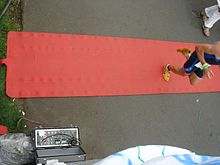Timing
As timing (in Austria and Bavaria timekeeping , commonly known Stoppung ) the exact measurement of is time interval referred to, especially in sports and in the work preparation .
The term is predominantly used in sporting competitions and in the organization of favorable processes in industry , as well as in some technical branches and in criminology .
On the other hand, in science and technology one usually speaks of time measurement , especially with high accuracy and when it is less about time intervals than measurement in time scales ( time systems such as CET, universal time (UT), atomic time , ephemeris and sidereal time ).
Types of timing
Measurement of time intervals

Measurements of a relative time by differentiation through automatic or manual start and stop processes, whereby the measurement can be made either on the track side or directly on the moving object itself. (e.g. start 2016-11-19 10:10:55 / stop 2016-11-19 10:45:56 / result 00:35:01)
- manual-visual with one or more mechanical or electronic stopwatches
- manual-acoustic: for example counting seconds , clock , eye-to-ear method
- manually with hand switch (triggering an electrical contact )
- with one or more light barriers - the most common measurement method in sport, but also in physics or gravimetry (geophysics)
- indirectly through methods of speed measurement , Doppler effect or the like.
- GPS, RFID or NFC-triggered actuators / sensors for documenting a time signal (see Strava / Endomondo / StoppOmat App)
Measurement in a time scale (selection, time measurement)

Measurement and / or documentation of the absolute time, which can possibly be differentiated by subsequent processing of two pieces of time information. (Unit e.g .: 2016-11-19 23:20:01)
- Eye-ear method (e.g. on a pendulum clock or time signal), coincidence method
- Stopwatch and its connection to an exact time system such as world time or atomic time
- digital or pressure chronograph , synchronized with a time signal transmitter
- rotating discs with electr. Contacts - for example with satellite cameras
- A quartz watch is triggered by reflected light or laser pulses
- other special methods z. B. in particle physics , chemistry , electronics or with PC programs.
- via a target photo or by surveying methods
- digital or analog documentation printing (see stoppomat or time clock ) synchronized with a time signal transmitter or central clock
- GPS, RFID or NFC-triggered actuators / sensors for documenting a time signal (see Strava / Endomondo )
Accuracies
The accuracies are determined by the following deviations.
- 5–15 minutes for the sundial or 10–30 seconds for the hourglass
- 0.05 to 0.5 seconds for manual stopping (with or without consideration of reaction time or personal equation )
- 0.01 to 0.001 seconds for simple coincidence methods
- Microseconds in many technical processes
- down to nanoseconds and below with precise electronics
- Femtoseconds play a role in laser experiments
- and for atomic clocks by up to 10-15 seconds (or 0.0000000000001 percent).
See also
Footnotes
- ↑ StoppOmat App for Android. Google Playstore, April 24, 2014, accessed November 19, 2016 .
